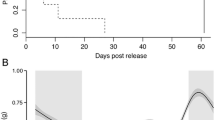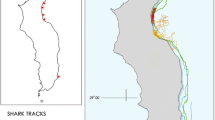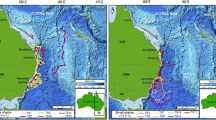Abstract
Acoustic telemetry was used to track vertical and horizontal movement patterns and to monitor the stomach temperatures of seven juvenile shortfin mako sharks (Isurus oxyrinchus Rafinesque) in the Southern California Bight from July to November 2002. Makos (80–145 cm fork length, FL) were attracted to the tracking vessel, where they were fed a mackerel containing an acoustic transmitter that reported temperature and pressure. Tracks ranged from 6.8–45.4 h. Collectively, the mako sharks spent 80% of the track record at 0–12 m, 15% at 12–24 m, and 5% at depths >24 m. The average horizontal swimming speed was 2.3 km h−1 or 0.55 FLs s−1, and the greatest distance traveled was 145 km in 45.4 h. For the six tracks >21 h, there was a positive correlation between body size and maximum depth. Makos used more of the water column during daylight hours. Mean stomach temperature was 3.8±1.5°C above ambient, and body size was positively correlated with both maximum and average stomach temperature. Stomach content analyses of four makos captured at the end of tracking verified the occurrence of feeding events as indicated by changes in stomach temperature.





Similar content being viewed by others
References
Arthur PG, West TG, Brill RW, Shulte PM, Hochachka PW (1992) Recovery metabolism of skipjack tuna, Katsuwonus pelamis, white muscle: rapid and parallel changes of lactate and phosphocreatine after exercise. Can J Zool 70:1230–1239
Bernal D, Dickson KD, Shadwick RE, Graham JB (2001a) Analysis of the evolutionary convergence for high performance swimming in lamnid sharks and tunas. Comp Biochem Physiol 129:695–726
Bernal D, Sepulveda CA, Graham JB (2001b) Water-tunnel studies of heat balance in swimming mako sharks. J Exp Biol 204:4043–4054
Brill RW, Lutcavage M, Metzger G, Bushnell P, Arendt M, Lucy J, Watson C, Foley D (2002) Horizontal and vertical movements of juvenile bluefin tuna (Thunnus thynnus), in relation to oceanographic conditions of the western North Atlantic, determined with ultrasonic telemetry. Fish Bull (Wash DC) 100:155–167
Cailliet GM, Bedford DW (1983) The biology of three pelagic sharks from California waters, and their emerging fisheries: a review. CalCOFI (Calif Coop Ocean Fish Investig) Rep 24:57–59
Cailliet GM, Martin LK, Harvey JT, Krusher D, Welden BA (1983) Preliminary studies on the age and growth of blue, Prionace glauca, common thresher, Alopias vulpinus, and shortfin mako, Isurus oxyrinchus, sharks from California waters. NOAA Tech Rep 8:179–188
California Department of Fish and Game (2001) Shark tagging news. California Department of Fish and Game, Long Beach, Calif. (News Letter Series)
California Department of Fish and Game (2003) Commercial fishing regulations: Marine Mammal Protection Act section 118. Available at http://www.dfg.ca.gov/licensing/pdffiles/2003CommFishDigest/MMProtectionAct.pdf
Carey FG, Robinson BH (1981) Daily patterns in the activities of swordfish, Xiphias gladius, observed by acoustic telemetry. Fish Bull (Wash DC) 79:277–292
Carey FG, Scharold JV (1990) Movements of blue sharks, Prionace glauca, in depth and course. Mar Biol 106:329–342
Carey FG, Teal JM (1969) Mako and porbeagle: warm bodied sharks. Comp Biochem Physiol 28:199–204
Carey FG, Teal JM, Kanwisher JW, Lawson KD (1971) Warm bodied fish. Am Zool 11:135–145
Carey FG, Teal JM, Kanwisher JW (1981) The visceral temperatures of mackerel sharks (Lamnidae). Physiol Zool 54:334–344
Casey JG, Kohler NE (1992) Tagging studies on the shortfin mako shark (Isurus oxyrinchus) in the western North Atlantic. Aust J Mar Freshw Res 43:45–60
Dagorn L, Bach P, Josse E (2000) Movement patterns of large bigeye tuna (Thunnus obesus) in the open ocean, determined using ultrasonic telemetry. Mar Biol 136:361–371
Dewar H, Domier M, Nasby-Lucas N (2004) Insights into young of the year white shark (Carcharodon carcharias) behavior in the Southern California Bight. Environ Biol Fishes (in press)
Federal Register (2001) Endangered and threatened wildlife; sea turtle conservation requirements; taking of threatened or endangered species incidental commercial fishing operations. Federal Register 166:165, microfiche
Goldman KJ (1997) Regulation of body temperature in the white shark, Carcharodon carcharias. J Comp Physiol 167:423–429
Graham JB, Dewar H, Lai NC, Lowell WR, Arce SM (1990) Aspects of shark swimming performance determined using a large water tunnel. J Exp Biol 151:175–192
Hanan DA, Holts DB, Coan AL Jr (1993) The California drift gill net fishery for sharks and swordfish, 1981–82 through 1990–91. Fish Bull (Wash DC) 175:89–95
Holland KN, Brill RW, Chang RKC (1990) Horizontal and vertical movements of yellowfin and bigeye tuna associated with fish aggregation devices. Fish Bull (Wash DC ) 88:493–507
Holland KN, Brill RW, Chang RKC, Sibert JR, Fournier D (1992) Physiological and behavioral thermoregulation in bigeye tuna, Thunnus obesus. Nature 358:410–412
Holts DB, Bedford DW (1993) Horizontal and vertical movements of the shortfin mako, Isurus oxyrinchus, in the Southern California Bight. Aust J Mar Freshw Res 44:45–60
Klimley AP (1993) Highly directional swimming by the scalloped hammerhead sharks, Sphyrna lewini, and subsurface irradiance, temperature, bathymetry and geomagnetic field. Mar Biol 117:1–22
Klimley AP (1994) The predatory behavior of the white shark. Am Sci 82:122–133
Klimley AP, Beavers SC, Curtis TH, Jorgensen SJ (2002) Movements and swimming behavior of three species of sharks in La Jolla Canyon, California. Environ Biol Fishes 63:117–135
Marcinek DJ, Blackwell SB, Dewar H, Freund EV, Farwell C, Dau D, Seitz AC, Block BA (2001) Depth and muscle temperature of Pacific bluefin tuna examined with acoustic and pop-up satellite archival tags. Mar Biol 138:869–885
McCosker JE (1987) The white shark, Carcharodon carcharias, has a warm stomach. Copeia 1987:195–197
Milligan CL (1996) Metabolic recovery from exhaustive exercise in rainbow trout. Comp Biochem Physiol A 113:51–60
O’Brien JW, Sunada JS (1994) A review of the southern California experimental drift longline fishery for sharks, 1988–1991. CalCOFI (Calif Coop Ocean Fish Investig) Rep 35:222–229
Pratt HL, Casey JG (1983) Age and growth of the shortfin mako, Isurus oxyrinchus, using four methods. Can J Fish Aquat Sci 40:1944–1957
Schaefer KM, Fuller DW (2002) Movements, behavior and habitat selection of bigeye tuna (Thunnus obesus) in the eastern equatorial Pacific, ascertained through archival tags. Fish Bull (Wash DC) 100:765–788
Stillwell CE, Kohler NE (1982) Food, feeding habits, and estimates of daily ration of the shortfin mako (Isurus oxyrinchus) in the North Atlantic. Can J Fish Aquat Sci 39:407–414
Taylor VB, Bedford DW (2001) Shortfin mako shark. In: Leet WS, Dewees CM, Klingbeil R, Larson EJ (eds) California’s living marine resources: a status report. California Department of Fish and Game, Resource Agency, Long Beach, pp 336–341
Weihs D (1973) Mechanically efficient swimming techniques for fish with negative buoyancy. J Mar Res 31:194–209
Westerberg H (1982) Ultrasonic tracking of Atlantic salmon (Salmo salar). I. Movements in coastal regions. Inst Freshw Res Drottningholm Rep 60:81–98
Acknowledgements
This work was supported by the California Sea Grant, the William H. and Mattie Wattis Harris Foundation, and partially by the National Science Foundation (IBN 0091987). Support was also provided by the Academic Senate of the University of California, San Diego, Ms. J. Sleeper, and Mr. R. Magee. We thank those who helped with various aspects of this research, especially, J. Donley, H. Lee, D. Cartamil, D. Fuller, A. Jenkins, K. Schaefer, the captain and crew of the R.V. “David Starr Jordan”, and R. Cosgrove for his work on the graphics. We are also indebted to J. Steinitz for his hard work in the search for funding for this project and to D. Holts, S. Smith, M. Scott, H. Dewar, C. Lowe, and the National Marine Fisheries Service for support and for the loan of the tracking system components. Thanks to R. Rosenblatt, R. Shadwick, K. Dickson, J. Hunter, P. Hastings, F. Powell, R. Brill, and one anonymous reviewer for their constructive comments on draft versions of this manuscript. Special thanks are expressed to D. Bernal for the many conversations that provided the basis for this research and to K. Dickson and the California State University of Fullerton for the loan of the tracking vessel. All experiments were performed under the guidelines of the Institutional Animal Care and Use Committee, of the University of California, San Diego (protocol S0008).
Author information
Authors and Affiliations
Corresponding author
Additional information
Communicated by J.P. Grassle, New Brunswick
Electronic Supplementary Material
Rights and permissions
About this article
Cite this article
Sepulveda, C.A., Kohin, S., Chan, C. et al. Movement patterns, depth preferences, and stomach temperatures of free-swimming juvenile mako sharks, Isurus oxyrinchus, in the Southern California Bight. Marine Biology 145, 191–199 (2004). https://doi.org/10.1007/s00227-004-1356-0
Received:
Accepted:
Published:
Issue Date:
DOI: https://doi.org/10.1007/s00227-004-1356-0





